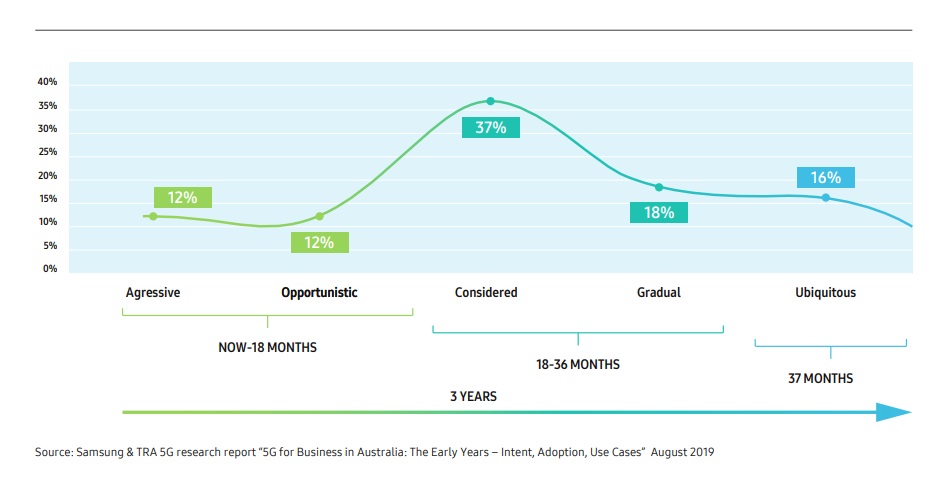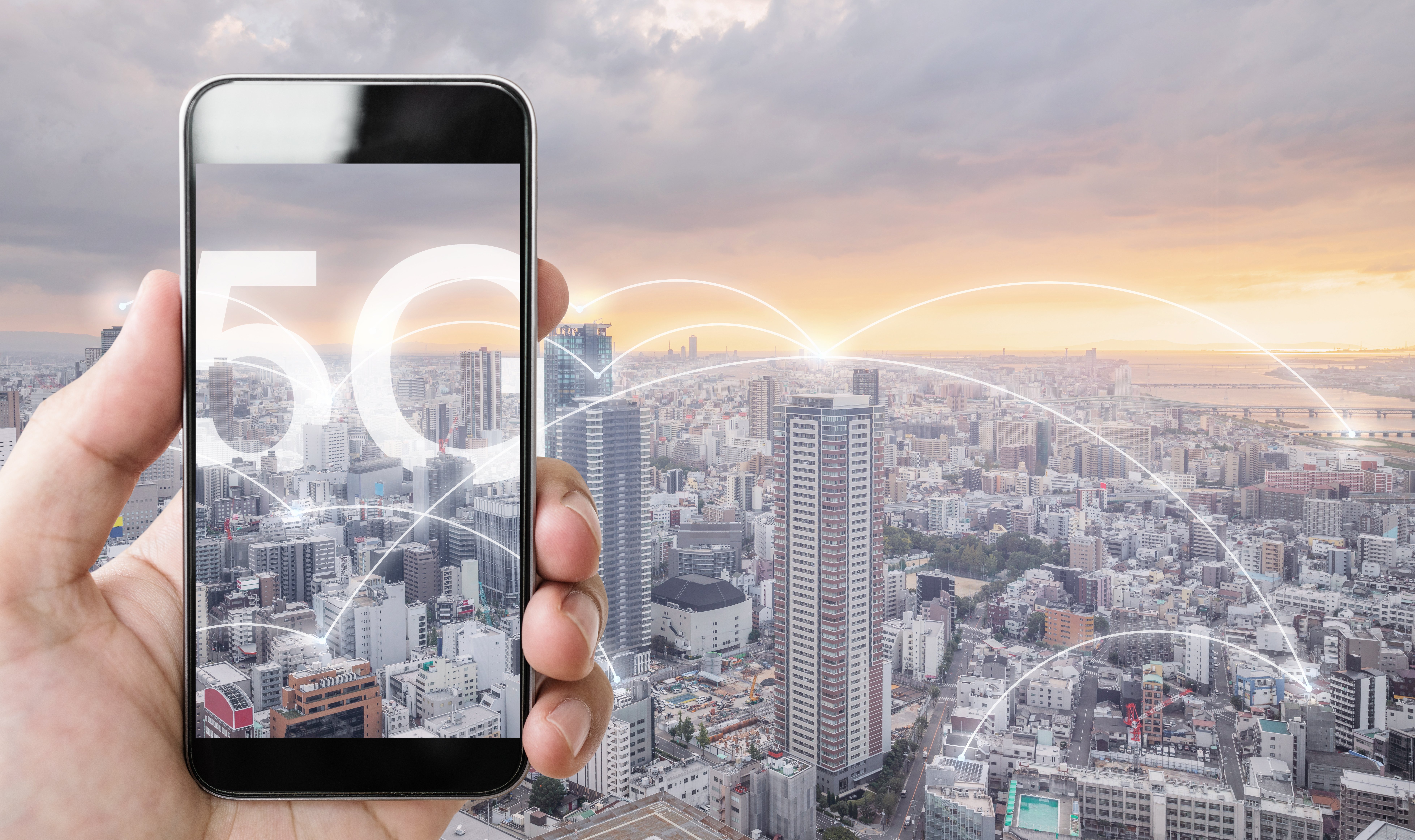Australia’s new super-fast 5G mobile network* is currently being rolled out across the country and business is looking to embrace its potential hoping it will deliver a major boost to productivity.
The fifth generation mobile network features new technologies and standards with the capacity to greatly improve data speeds, responsiveness (lower latency) and connectivity, all with greater reliability and resilience.
To understand the potential in 5G for business, as well as the attitudes entrepreneurs have to embracing the new technology, Samsung Electronics Australia, partnered with Tech Research Asia (TRA), to gather the views of more than 800 technology decision makers from a cross-section of industries around the nation. The result is the report and whitepaper 5G for Business in Australia.
The report reveals that nearly a quarter (24%) of businesses in Australia intend to adopt 5G services for business in the coming 18 months, with almost 80% of Australian businesses set to adopt 5G related mobility services within the next three years.
Approximately 37% of Australian businesses are taking a “Considered” approach to 5G adoption, while 24% are being either “Aggressive” (at 12%) or “Opportunistic” (at 12%) in terms of rapid or early adoption of 5G respectively. 18% of participants said that their adoption plans would be “Gradual” and in line with network deployments while 16% stated that they have no specific strategy until 5G is “Ubiquitous”. Just 4% of respondents classified their approach to 5G in a “Deliberation” stage where they are needing to determine the actual benefits and availability of 5G.
The chart below outlines their views.

Amid those findings, the report reveals that 68% of Australian businesses feel that their operations are constrained by current network performance, and 60% of businesses feel there is a need for 5G services to meet business needs above current 4G connectivity.
More than two-thirds (68%) of the businesspeople the researchers spoke to said the company operations are constrained by their network speeds and performance (67% for mobile and 69% for fixed networks). They said the resulting impact was most detrimental when employees are mobile, away from the office, engaging with clients, and even working in the office.
The report dubbed it a “bandwidth tax” that curtails their ability to work effectively and productively. The upside is 5G can help alleviate this problem from both a connectivity and security perspective.
And while early 5G solutions implemented by businesses will focus on bandwidth-centric approaches, the report has indicated that they will seek to quickly develop and integrate higher value-added solutions such as slicing and edge computing. These solutions present the opportunity to implement IoT, AI-supported decision-making tools, predictive analytics and real-time data.
Samsung Electronics Australia Head of Enterprise and Government, IT and Mobile Danny Mandrides said 5G is both a trigger and an engine that will transform the way Australians live and work, especially when it comes to how businesses operate in an increasingly mobile driven economy.
“Now more than ever before Australian businesses are telling us that they demand the bandwidth, stability, and opportunities that 5G will bring,” he said.
The TRA research for Samsung did reveal three key concerns based around pricing, device availability and capability, and network coverage, however Australian businesses recognised the benefits of 5G extends beyond speed to include other major capabilities such as edge computing, multi-device connectivity, low network latency and network slicing.
Organisations see 5G enhancing their current and future operations in areas including customer engagement, data access and management, supporting cloud services consumption and facilitation of intelligent workplaces.
Ways to use 5G
One of the most impressive aspects of the investigation into how business will use 5G was the multiple use cases identified in the 5G for Business in Australia report.
Here are eight ways Australian companies are already exploring the potential of 5G.
Improved customer service and engagement in the consumer banking sector: A big four Australian bank trialling 5G branch connectivity linked to smartphones and Samsung’s DeX solution designed to provide seamless connectivity and information access for its mobile customer service and banking employees.
Intelligent workstyles, costs reductions and efficiencies in the manufacturing sector: A production site connecting multiple device sensors combined with AI analytics to a smart device dashboard app that provides real-time information on manufacturing performance and quality to help reduce defects and materials costs.
Intelligent workstyles, employee health and safety in the mining and exploration sector: The use of CCTV video analytics linked to small site 5G networks combined with AI biometric analysis to identify appropriately authorised employees in high risk areas and determine if they’re wearing appropriate safety clothing and equipment. If not, an alert is sent to their smartphone to vacate the area.
Cost reduction/customer engagement in field services: An Australian reality technology hardware company equipping headsets with 5G connectivity to support augmented reality solutions for service personnel designed to reduce service time and provide real-time access to ‘how to’ videos/tutorials when undertaking more complex servicing requirements.
Data management, information access, health and safety/asset protection for government and emergency services: An Australian AI company that has created 5G connected drones to undertake aerial surveillance of areas under bush fire threat equipped with AI to identify issues and assets on the ground in real-time to assist emergency service and fire crews.
Data management, cost reduction, operational efficiencies in the utilities sector: The potential of using 5G to upload data to 3D modelling engines in real-time rather than ‘batch-process’ multi-terabyte transfers physically transferred to data storage at end of each working day.
Customer service, real-time augmented reality in the retail sector: Assessing the potential of using AR headsets to allow shoppers to ‘try’ clothing, linked to analytics engines drawing from cloud-located shopping data to make recommendations on similar or complementary products.
Patient services, cost efficiencies in health sector: Assessing the deployment of small site FWA 5G connectivity and smart devices to provide more efficient
access to patient data and information with a longer term goal of supplementing with AI-assistance, remote surgery, asset management and connected IoT health devices.
Better buses
One way everyone could potentially feel the impact of 5G is on their commute to work.
As the executive director of one state transport provider told the researchers: “In transport the low latency aspects alone mean it’s ground breaking. We’re actively trying to activate anything around IoT [internet of things] and analytics and then bring that through to 5G.
“The concept of IoT onto buses for example to monitor potholes and provide real time information is compelling. The ability to predict and anticipate what will happen on our transport network is critical to our customers and our service performance.”
And with artificial intelligence (AI) seen as one of the greatest tech trends ahead, the 5G for Business in Australia report reveals that Australia’s 800 technology decision makers see 5G as both the fuel for AI and the enabler of its delivery.
As the report explains: “In a 5G connected world, the amount of data created through massive IoT/machine to machine networks will be, to use a non-analyst term, ‘huge’. The ability to rapidly move, ingest, exfiltrate and access this data will be critical to feeding the learning requirements of AI-supported tools and analysis.
“Likewise, AI, or more accurately, machine learning will enable the service providers to better manage their 5G networks and support planning, management and operational needs. The sheer complexity of the network environment delivering all those services we’ve already mentioned almost dictates a high degree of machine learning to optimise network performance.”
To understand more about 5G and the impact it will have, you can download Samsung’s 5G for Business in Australia for free here.
*5G is Available on selected plans on eligible 5G networks. 5G networks are progressively being rolled out across Australia by selected operators. Current availability is limited to major capital city CBDs and other select high traffic areas. Actual speeds achievable will vary depending on service availability and other factors. For more details, contact your participating operator.




















Trending
Daily startup news and insights, delivered to your inbox.